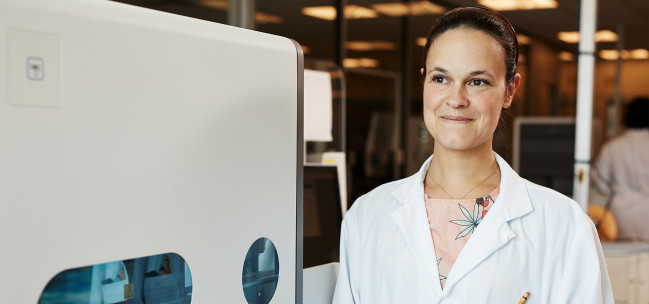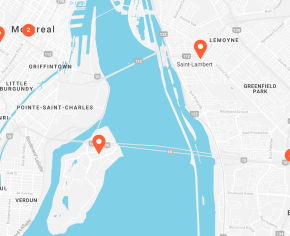What you get with an infiltration at Imagix:
- Fast service close to home for greater convenience
- A service covered by the RAMQ
- A team of 50 dedicated and attentive radiologists
- State-of-the-art equipment
What does a cortisone infiltration involve?
Infiltrations of cortisone (a powerful anti-inflammatory) are used to treat a number of musculoskeletal problems, including:
- Shoulder pain (tendonitis, bursitis, impingement syndrome, osteoarthritis)
- Knee pain (osteoarthritis, torn meniscus, arthritis, pes anserinus tendinitis)
- Elbow pain (epicondylitis)
- Hip pain (osteoarthritis, trochanteric bursitis)
- Carpal tunnel syndrome
- Stenosing tenosynovitis (trigger finger)
- Osteoarthritis of the thumb
- Arnold’s neuralgia
Pain relief may last several months or be permanent. The infiltration can be repeated if symptoms return.
Types of infiltrations available:
Arthrography: This is an imaging test that involves injecting dye into a joint before X-rays are taken. It allows the radiologist to confirm the correct position of the needle for the injection.
Facet block: This is an injection of an anti-inflammatory drug into the spine to temporarily relieve lumbar, cervical or dorsal pain.
Shoulder infiltration: This is an injection of medication into the shoulder. It is intended to relieve pain due to diseases such as osteoarthritis, tendonitis, bursitis, capsulitis, and many others.
Knee infiltration: This procedure involves injecting cortisone to relieve knee pain, whether for knee tendonitis, knee bursitis, arthritis or osteoarthritis when traditional treatment has not worked.
Hip infiltration: This technique involves injecting cortisone to relieve pain caused by hip tendonitis, bursitis or osteoarthritis.
Wrist infiltration: This technique involves injecting medication to relive pain in the wrist due to osteoarthritis, arthritis, tendonitis, etc.
Hand infiltration: This is the injection of cortisone into the joints of the hand to relieve pain due to base-of-thumb osteoarthritis, osteoarthritis of the finger joints, tendonitis or "trigger finger."
Arnold’s nerve infiltration: This infiltration involves injecting medication around the nerve to relieve the pain of occipital neuralgia.
Ankle infiltration: This technique consists of injecting cortisone into the ankle joints to relieve pain due to tendonitis, arthritis or osteoarthritis.
Elbow infiltration: This is an injection of cortisone into the elbow to relieve pain that may be caused by medial or lateral epicondylitis, intra-articulaire, bursitis, or pain secondary to nerve compression .
Foot infiltration: This is an injection of cortisone into the foot to relieve pain that may be related to various causes: osteoarthritis of the toes, plantar fasciitis, bursitis, tendonitis, Morton’s neuroma, etc.).
Our services in infiltrations
Your doctor will indicate the infiltration method in your prescription. Depending on the area being treated, the radiologist may modify this method for better results.
To help you plan, keep in mind that the consultation can last 20 to 30 minutes, even if the procedure itself only takes 10 to 15 minutes.
How the consultation works
Step 1: The health care professional will ask you to get into an optimal position for your test. He or she will help you get into the best position possible for the type of intervention you are having. The radiologist will perform an initial ultrasound and examine the affected area.
Step 2: The radiologist then injects cortisone or a viscosupplement (after local anesthesia, if necessary) into the area indicated by the assessment.
Where to go for an infiltration?
You can make an appointment for your infiltrations at one of the following Imagix clinics:
- Ville de Mont Royal
- Granby
- Boucherville
- Brossard
- Châteauguay
- Laval
- Trois-Rivières
- Saint-Eustache
- Saint-Laurent
- Sainte-Thérèse
FAQ
How long does a cortisone infiltration last?
Pain relief may last several months or be permanent. The infiltration can be repeated if the symptoms reappear.
How much does an infiltration cost?
Our infiltrations are covered by the RAMQ.
How long should I wait between infiltrations?
We recommend not exceeding four infiltrations per year per injection site. A minimum delay of 31 days is necessary between two ultrasound-guided infiltrations at Imagix. A minimum delay of four weeks is recommended between two fluoroscopy-guided infiltrations.
Can I walk after a knee infiltration?
A period of relative rest is necessary following an infiltration, varying from 48 hours to three weeks depending on the procedure (intra-articular injection vs. calcific lavage).
A medical prescription is required to perform this examination. The cost of this examination is covered by the Régie de l'assurance maladie du Québec (RAMQ) at Imagix when prescribed by a physician.*
*Members of the College des Médecins du Québec (CMQ) registered in the Quebec Physicians Directory

